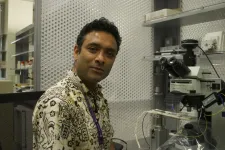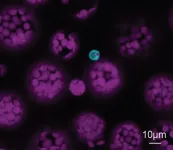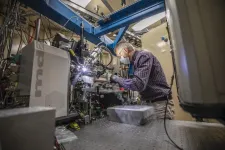(Press-News.org) Imagine you gave the exact same art pieces to two different groups of people and asked them to curate an art show. The art is radical and new. The groups never speak with one another, and they organize and plan all the installations independently. On opening night, imagine your surprise when the two art shows are nearly identical. How did these groups categorize and organize all the art the same way when they never spoke with one another?
The dominant hypothesis is that people are born with categories already in their brains, but a study from the Network Dynamics Group (NDG) at the Annenberg School for Communication has discovered a novel explanation. In an experiment in which people were asked to categorize unfamiliar shapes, individuals and small groups created many different unique categorization systems while large groups created systems nearly identical to one another.
"If people are all born seeing the world the same way, we would not observe so many differences in how individuals organize things," says senior author Damon Centola, Professor of Communication, Sociology, and Engineering at the University of Pennsylvania. "But this raises a big scientific puzzle. If people are so different, why do anthropologists find the same categories, for instance for shapes, colors, and emotions, arising independently in many different cultures? Where do these categories come from and why is there so much similarity across independent populations?"
To answer this question, the researchers assigned participants to various sized groups, ranging from 1 to 50, and then asked them to play an online game in which they were shown unfamiliar shapes that they then had to categorize in a meaningful way. All of the small groups invented wildly different ways of categorizing the shapes. Yet, when large groups were left to their own devices, each one independently invented a nearly identical category system.
"If I assign an individual to a small group, they are much more likely to arrive at a category system that is very idiosyncratic and specific to them," says lead author and Annenberg alum Douglas Guilbeault (Ph.D. '20), now an Assistant Professor at the Haas School of Business at the University of California, Berkeley. "But if I assign that same individual to a large group, I can predict the category system that they will end up creating, regardless of whatever unique viewpoint that person happens to bring to the table."
"Even though we predicted it," Centola adds, "I was nevertheless stunned to see it really happen. This result challenges many long—held ideas about culture and how it forms."
The explanation is connected to previous work conducted by the NDG on tipping points and how people interact within networks. As options are suggested within a network, certain ones begin to be reinforced as they are repeated through individuals' interactions with one another, and eventually a particular idea has enough traction to take over and become dominant. This only applies to large enough networks, but according to Centola, even just 50 people is enough to see this phenomenon occur.
Centola and Guilbeault say they plan to build on their findings and apply them to a variety of real—world problems. One current study involves content moderation on Facebook and Twitter. Can the process of categorizing free speech versus hate speech (and thus what should be allowed versus removed) be improved if done in networks rather than by solitary individuals? Another current study is investigating how to use network interactions among physicians and other health care professionals to decrease the likelihood that patients will be incorrectly diagnosed or treated due to prejudice or bias, like racism or sexism. These topics are explored in Centola's forthcoming book, CHANGE: How to Make Big Things Happen (Little, Brown & Co., 2021).
"Many of the worst social problems reappear in every culture, which leads some to believe these problems are intrinsic to the human condition," says Centola. "Our research shows that these problems are intrinsic to the social experiences humans have, not necessarily to humans themselves. If we can alter that social experience, we can change the way people organize things, and address some of the world's greatest problems."
INFORMATION:
The study, entitled "Experimental Evidence for Scale—Induced Category Convergence across Populations," was published in Nature Communications. Authors include Guilbeault; Andrea Baronchelli, City University London; and Centola. This study was partially funded by a Dissertation Award granted to Guilbeault by the Institute for Research on Innovation and Science at the University of Michigan.
New research has found as climate change causes the world's oceans to warm, baby sharks are born smaller, exhausted, undernourished and into environments that are already difficult for them to survive in.
Lead author of the study Carolyn Wheeler is a PhD candidate at the ARC Centre of Excellence for Coral Reef Studies at James Cook University (Coral CoE at JCU) and the University of Massachusetts. She examined the effects of increased temperatures on the growth, development and physiological performance of epaulette sharks--an egg-laying species found only ...
COLUMBUS, Ohio - An unfortunate truth about the use of mechanical ventilation to save the lives of patients in respiratory distress is that the pressure used to inflate the lungs is likely to cause further lung damage.
In a new study, scientists identified a molecule that is produced by immune cells during mechanical ventilation to try to decrease inflammation, but isn't able to completely prevent ventilator-induced injury to the lungs.
The team is working on exploiting that natural process in pursuit of a therapy that could lower the chances for lung damage in patients on ventilators. Delivering high levels of the helpful molecule with a nanoparticle was effective ...
Abu Dhabi, United Arab Emirates, January 12, 2020: New research from NYU Abu Dhabi's Laboratory of Neural Systems and Behavior for the first time used an animal model to demonstrate how abnormal sleep architecture can be a predictor of stress vulnerability. These important findings have the potential to inform the development of sleep tests that can help identify who may be susceptible -- or resilient -- to future stress.
In the study, Abnormal Sleep Signals Vulnerability to Chronic Social Defeat Stress, which appears in the journal Frontiers in Neuroscience, NYUAD Assistant Professor of Biology Dipesh Chaudhury and Research Associate Basma Radwan describe their development of a mouse ...
ORLANDO, Fla. -- A new national survey by the Orlando Health Heart & Vascular Institute finds many Americans would delay doctor's appointments and even emergency care when COVID-19 rates are high. The survey found 67 percent of Americans are more concerned about going to medical appointments when COVID-19 rates are high in their area and nearly three in five (57 percent) are hesitant to go to the hospital even for an emergency.
In a time when every trip out of the house and every person we come in contact with poses a threat of contracting COVID-19, ...
WASHINGTON - Computer-based artificial intelligence can function more like human intelligence when programmed to use a much faster technique for learning new objects, say two neuroscientists who designed such a model that was designed to mirror human visual learning.
In the journal Frontiers in Computational Neuroscience, Maximilian Riesenhuber, PhD, professor of neuroscience, at Georgetown University Medical Center, and Joshua Rule, PhD, a postdoctoral scholar at UC Berkeley, explain how the new approach vastly improves the ability of AI software to quickly learn new visual ...
The Korea Institute of Science and Technology (KIST) has announced that the research team led by Dr. Kim Kyoung-Whan at the Center for Spintronics has proposed a new principle about spin memory devices, which are next-generation memory devices. This breakthrough presents new applicability that is different from the existing paradigm.
Conventional memory devices are classified into volatile memories, such as RAM, that can read and write data quickly, and non-volatile memories, such as hard-disk, on which data are maintained even when the power is off. In recent years, related academic and industrial fields have been combining their advantages to accelerate the development of next-generation memory that is fast and capable of maintaining data even when the power is off.
A spin memory ...
The leaf vasculature of plants plays a key role in transporting solutes from where they are made - for example from the plant cells driving photosynthesis - to where they are stored or used. Sugars and amino acids are transported from the leaves to the roots and the seeds via the conductive pathways of the phloem.
Phloem is the part of the tissue in vascular plants that comprises the sieve elements - where actual translocation takes place - and the companion cells as well as the phloem parenchyma cells. The leaf veins consist of at least seven distinct cell types, with specific roles in transport, metabolism and signalling.
Little is known about ...
A team of HIV researchers, cellular biologists, and biophysicists who banded together to support COVID-19 science determined the atomic structure of a coronavirus protein thought to help the pathogen evade and dampen response from human immune cells. The structural map - which is now published in the journal PNAS, but has been open-access for the scientific community since August - has laid the groundwork for new antiviral treatments tailored specifically to SARS-CoV-2, and enabled further investigations into how the newly emerged virus ravages the human body.
"Using X-ray crystallography, we built an ...
A new study published in the American Journal of Preventive Medicine found a 25% increase in food insufficiency during the COVID-19 pandemic. Food insufficiency, the most extreme form of food insecurity, occurs when families do not have enough food to eat. Among the nationally representative sample of 63,674 adults in the US, Black and Latino Americans had over twice the risk of food insufficiency compared to White Americans.
"People of color are disproportionately affected by both food insufficiency and COVID-19," said Jason Nagata, MD, MSc, assistant professor of pediatrics at the University of California, San Francisco and lead author on the study. "Many of these individuals have experienced job loss and higher rates of poverty during the ...
During April 2020, while the UK was in full lockdown, there was a drop of more than a third in the number of people seeking help for mental illness or self-harm according to research involving 14 million people registered at general practices across the four nations of the UK which was published today in The Lancet Public Health*.
The research, 'Effects of the COVID-19 pandemic on primary care-recorded mental illness and self-harm episodes in the UK: a population-based cohort study', was conducted by the National Institute for Health Research Greater Manchester Patient Safety Translational Research Centre (NIHR GM PSTRC). The Centre is a partnership between The University of Manchester and Salford Royal NHS Foundation ...



